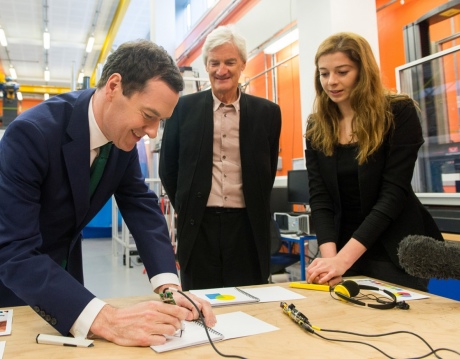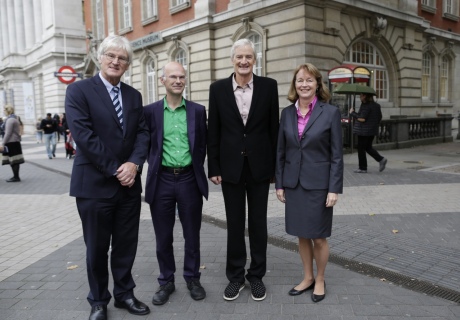

A new generation of much-needed graduate engineers and technology leaders will be educated at the Dyson School of Design Engineering.
The Dyson School of Design Engineering was launched today at Imperial by George Osborne, the Chancellor of the Exchequer, and inventor and industrial designer Sir James Dyson. The School has been established thanks to a £12 million donation from the James Dyson Foundation.
The School, the first new engineering department to be established at Imperial in two decades, will be housed in the former Post Office building on Exhibition Road, which the College has recently purchased from the Science Museum and will in the future be known as the Dyson Building of Design Engineering.
Learn about design engineering in the video below.
The School will begin teaching a new four year undergraduate MEng in Design Engineering in October 2015. The programme will teach a range of engineering fundamentals, design thinking, creative problem solving, and management and communication skills.
“Design engineering combines the best of technical expertise with creativity and the Dyson School of Design Engineering is uniquely placed to bring these together in its student experience and research,” said Professor Alice Gast, President of Imperial College London.
She added, “Imperial and Dyson passionately share a vision for educating engineers to elicit innovative thinking and problem solving. The James Dyson Foundation’s generous donation, along with Dyson’s industrial expertise, gives us the opportunity to create a world-leading School for a new kind of engineer to design the future."
The curriculum, developed with Dyson engineers alongside other stakeholders, contains industrial placements, development of industry project briefs, and an entrepreneurship module.
Sir James Dyson said: “We want to create engineers who are bold and commercially astute. They will use their skills, nurtured in the Dyson School, to develop future technology that will catalyse Britain’s economic growth.”
Visiting Imperial today to learn about the plans for the Dyson School the Chancellor Rt Hon George Osborne MP welcomed its vision: "It is fantastic to hear about the new partnership between the Dyson Foundation and Imperial College to open the new Dyson School of Design Engineering that will play a key role in training the next generation of design engineers," he said.

Above: The Chancellor tries out LUMO, a graphic reader for blind and visually impaired people, designed by Imperial alumnus Anna Wojdecka (right)
With recruitment underway of the first 40 students on the MEng in Design Engineering, the course has already attracted six applications for every place available. Of the applications received, 40 per cent have been from women, which compares to 13 per cent as the usual number of female applicants to engineering courses.
The School’s first cohort will use Imperial’s existing facilities from October 2015. The annual intake will increase to 100 by October 2017, when teaching moves to the new building. When completed, industry standard equipment and studio space will enable 400 students to design, prototype and test new product ideas.
The Dyson School will become a hotbed of ideas and creativity
– Professor Jeff Magee
Dean of the Faculty of Engineering
“The Dyson School will become a hotbed of ideas and creativity,” said Professor Jeff Magee, Dean of the Faculty of Engineering. “It will lead to engineered products that have the potential to revolutionise the way we go about our lives. Students will receive a rigorous education in design engineering and go on to be leaders in the next generation of problem-solving engineers.”
In addition to undergraduate provision and a design engineering research programme, the School will also offer the existing Innovation Design Engineering (IDE) and Global Innovation Design (GID) double Masters courses, run jointly by Imperial College London and the Royal College of Art.
Existing students and alumni of these courses presented their design engineering projects to the Chancellor and James Dyson during their visit today. Among them were Anna Wojdecka, an alumnus of the IDE course (pictured above), who demonstrated her invention LUMO which enables blind and visually impaired people to read shapes, graphs, diagrams and colours by translating colours into sound and black lines into tactile feedback. Another group of students explained how their robot prototypes, developed with Q-Bot Ltd, are designed to access areas which are hard to reach for humans and conduct tasks such as spraying insulating foam into floor voids under home. (Find out more and explore other Imperial design engineering projects).
Professor Peter Childs, the first Director of the Dyson School of Design Engineering, said: “The new School will enable us to make the most of our students’ talent and creativity, building on the foundations of design engineering teaching laid through our stunningly successful 35 year old partnership with the Royal College of Art. Through these postgraduate courses, our students have developed innovative prototypes, such as a radio that works out what music you want to listen to by detecting your facial expression, and flying drone technology that is designed to rescue people who are drowning. We expect the School to galvanise such ingenuity, becoming a manufacturing and design hub in the heart of South Kensington, producing gadgets, experiences and services that have the potential to transform our lives.”

Jeff Magee (Dean of Engineering), Peter Childs (Director of the Dyson School of Design Engineering) and Alice Gast (President of Imperial) with James Dyson
South Kensington is today home to many of Britain’s best museums and world-leading cultural and educational institutions.
Welcoming the announcement, Bernard Taylor, Chairman of the Royal Commission for the Exhibition of 1851, said, "The sale of the Science Museum’s Post Office building to Imperial College to become the Dyson School of Design Engineering is very exciting. We strongly support this initiative. Our Albertopolis cultural estate in South Kensington was founded with the profits of the Great Exhibition and this new use of the building fits perfectly with Prince Albert’s aim, and our objects, of increasing the influence of science and art on productive industry. The new school will become a major contributor to achieving this mission and I wish it every possible success.”
The reinvestment of proceeds from the sale of the old Post Office building, approved by the Chancellor, will allow the Science Museum to invest more than £20 million in transforming around a third of the over the next five years, including several new permanent galleries.
Dyson and Imperial
James Dyson is a long standing supporter of the Innovation Design Engineering masters programme run jointly by Imperial College London and the Royal College of Art. In 2014 Dyson Ltd announced an investment of £5m in a new robotics lab with Imperial College London. The research focuses on vision systems, leading to new robotic capabilities, creating a generation of robots that understand the world around them – and can intelligently interact as it changes. The James Dyson Foundation’s £12m donation to Imperial College London is the charity’s largest ever single gift.
Photo credit: The Science Museum
Article text (excluding photos or graphics) available under an Attribution-NonCommercial-ShareAlike Creative Commons license.
Photos and graphics subject to third party copyright used with permission or © Imperial College London.
Reporters
Tom Miller
Communications and Public Affairs

Contact details
Email: press.office@imperial.ac.uk
Show all stories by this author
Martin Sayers
Communications Division

Contact details
Tel: +44 (0)20 7594 8140
Email: m.sayers@imperial.ac.uk
Show all stories by this author
Colin Smith
Communications and Public Affairs

Contact details
Email: press.office@imperial.ac.uk
Show all stories by this author
Leave a comment
Your comment may be published, displaying your name as you provide it, unless you request otherwise. Your contact details will never be published.





Comments
Comments are loading...